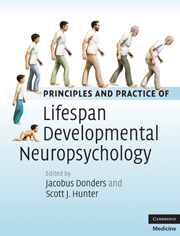Book contents
- Frontmatter
- Contents
- Contact information for authors
- Biography for Jacobus Donders and Scott J. Hunter
- Introduction
- Section I Theory and models
- 1 A lifespan review of developmental neuroanatomy
- 2a Developmental models in pediatric neuropsychology
- 2b Models of developmental neuropsychology: adult and geriatric
- 3 Multicultural considerations in lifespan neuropsychological assessment
- 4 Structural and functional neuroimaging throughout the lifespan
- Section II Disorders
- Index
- Plate section
- References
4 - Structural and functional neuroimaging throughout the lifespan
from Section I - Theory and models
Published online by Cambridge University Press: 07 May 2010
- Frontmatter
- Contents
- Contact information for authors
- Biography for Jacobus Donders and Scott J. Hunter
- Introduction
- Section I Theory and models
- 1 A lifespan review of developmental neuroanatomy
- 2a Developmental models in pediatric neuropsychology
- 2b Models of developmental neuropsychology: adult and geriatric
- 3 Multicultural considerations in lifespan neuropsychological assessment
- 4 Structural and functional neuroimaging throughout the lifespan
- Section II Disorders
- Index
- Plate section
- References
Summary
Introduction
From a neuroimaging perspective, the changes that occur over the lifespan in brain structure and functional capacity, both developmental and degenerative, must be considered in combination with the cognitive, behavioral, and psychosocial status of an individual when utilizing neuroimaging for either clinical or research purposes. In this chapter we selectively review some common conventional neuroimaging techniques and their application, followed by discussion of advanced structural and functional neuroimaging methods and likely future directions.
Conventional neuroimaging methodologies
Historically speaking, older structural and functional neuroimaging techniques are often referred to as “conventional” imaging methodologies, though the categorization of what techniques are considered cutting-edge versus those which are labeled conventional continues to evolve over time as ever-newer imaging technologies are developed. Structural imaging techniques such as computed axial tomography (CAT or CT) and magnetic resonance imaging (MRI) have become routine neuroimaging methodologies, with wide availability in terms of both scanning technology and technical capacity for their implementation and interpretation. CT scanning was the earliest method of structural brain imaging to come into common clinical and research use, and utilizes computerized integration of multiple X-ray images to generate cross-sectional views of the brain. While CT remains the optimal method for some neuroimaging purposes (e.g. visualization of bone or acute hemorrhage), the exposure to radiation involved in the technique and its relatively low contrast between classes of brain tissue have led CT largely to be supplanted by structural MRI in research and for many clinical applications.
- Type
- Chapter
- Information
- Publisher: Cambridge University PressPrint publication year: 2010
References
- 2
- Cited by

